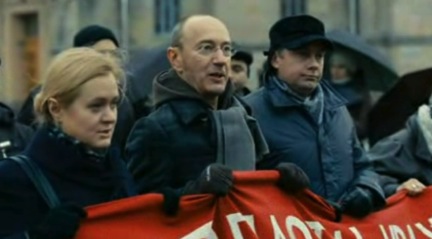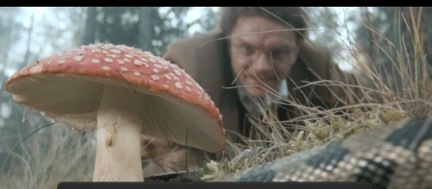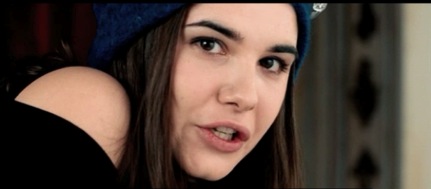Creacl (креакл) is the latest addition to a list of existing euphemisms used to describe the phenomenon of a middle class in Russia. Other terms include creative class, network hamster (setevoi khomiak), office plankton (offisnyi plankton), moral elite (nravstvennaia elita).
The ironic term is an acronym of creative class (креативный класс) but also refers to Greek mythology: in Russian, creacl rhymes with Gerakl (Hercules). In one of its first appearances, the term was used by levsharansky2, a popular LiveJournal blog (which is believed to be run by pro-Kremlin bloggers) to describe the twelve labors of Creacl: brainstorming in the hipsters’ cafe Jean-Jacques; attending gay pride parades; taming lumpen supporters of the Putin regime; or purchasing a new i-Phone or i-Pad. [1]
If we look at the methods of creating humor in Russian satire, it often depends on the incongruity of applying a lofty style to describing a routine, e.g. Est’ mnenie, chto nado pomyt’ posudu (There is an opinion that you need to do the dishes). Here the jargon of the Soviet partocracy and propaganda is applied to a household chore thereby producing an ironic effect. Similarly, the term creacl appeared at the time when the definition creative class became a cliché overused in political polemics, while an unexpected connotation of grandeur, encrypted in the word form of creacl unmistakably brought about a humorous effect and assigned new meanings to the definition.
The term took on popular use in January 2013 in connection with Aleksei Kabanov’s criminal case. Kabanov, a popular blogger and chef, was the co-founder of the Project O.G.I. (1998-2012) literary cafes in downtown Moscow that gathered Russia’s bohemians, prominent writers, musicians, and humanities students. In January 2013, Aleksei Kabanov launched a Facebook campaign amongst his 1500 friends to help him search for his wife, Irina Cherska, who, according to him, went missing after a family quarrel. While volunteers and police searched for the woman, Kabanov kept updating his Facebook account with emotional posts: “Irka still missing” (“Irka ne nashlas’”). When investigators found body fragments of Cherska in a car that Kabanov borrowed from a friend a few days later, he confessed to committing the murder. He revealed that he strangled and then dismembered his wife, hoping to get rid of her body later. Kabanov was detained and faces up to 15 years in jail for murder. Irina Cherska was 39, and the mother of three young children.
Kabanov family’ tragedy sparked a polemic about the controversial nature of the formation of the Russian middle class casting doubt on the very possibility of its existence. In a post that further promoted the usage of the term creacl, Pavel Prianikov noted that the Kabanovs were seen by many as model representatives of creative class: both were intellectuals, active participants in anti-Kremlin protests, prolific bloggers, and emerging small business owners. However, as Prianikov further suggested, what most people didn’t see behind this façade, was a large family with three kids who rented a small studio apartment in the suburbs, barely had any income through scarce freelance journalist jobs, and went bankrupt in an attempt to open their own restaurant in Moscow.[2] The discussions surrounding Kabanov’s crime centered on the deep sociocultural and economic problems that impede the normal functioning of the “middle class” in Putin’s Russia at all levels, including property ownership, income, socioeconomic values, and stability. Many Putin supporters gloated over the opposition revealing its real face (especially after the protesters denounced the violence at the May 2012 Bolotnaya Square demonstrations, declaring themselves a peaceful group). The Kabanov tragedy should be understood not as an insight into the opposition, but as a structural absence of opportunities for a thriving middle class in Russia.
The phonetics of the word creacl further emphasizes this idea: based on the satirical device of the elevation of the low, the greatest irony of the term is that it might as well reveal the nature of something that in fact never existed.
Class Issue and Creacls in Recent Russian Cinema
Paradoxical as it might seem, recent Russian cinema has not clearly revealed class difference as a realistic aspect of Russian social fabric. Until recently (and especially in the films released in 2011), the class issue was, at best, replaced with the idea of generational conflict. Here the focus was either on a lost generation of those born in the 60s-70s and unable to adjust to a new social reality (Gromozeka, 2011), or on post-Soviet Russians born in a country that no longer exists, who are eternally nostalgic for the totems of their youth, such as young pioneers, Moidodyr (a magical creature from a 1923 Soviet poem by Kornei Chukovsky) or medved’-kosmonavt (the Cosmounaut Bear) (Chapiteau-Show, 2011).
When the issue of class difference finally began to appear in the films of 2011-12—Elena (2011), Kokoko (2012), Twilight Portrait (Portret v sumerkakh, 2011), The White Moor (Belyi Mavr, 2012), Dukhless (2012), An Office Romance: Our Time (Sluzhebnyi roman: Nashe Vremia, 2011)—we can’t help but notice that the representation of class in the majority of these films was reduced to the depiction of either lumpens from the city outskirts or the upper classes and minigarchs from the prestigious zones of the city. In the latter case, the directors and producers appeared to unequivocally accept that this group of people inhabiting Moscow’s suburbs Rublevka and Zhukovka are numerous enough to represent a vast social phenomenon of the upper class in Russia. This stands true even for the films with a clearly articulated agenda of social awareness, such as Elena and Twilight Portrait. What was obviously lacking in the films mentioned above was a representation of a middle class: qualified specialists—representatives of intellectual professions, or midlevel managers and small business owners.
Some serious reservations have been recently expressed by sociologists over the existence of a middle class in Russia (Samson, Krasil’nikova 2012),[3] who argue that generally accepted socioeconomic and ethical values of “middle class” that correspond to Western understanding of the concept have not been formed in contemporary Russia. The same hesitation is obvious in cinematic representations of the middle class. In fact, many contemporary Russian films are dealing with comical re-enactments of multiple euphemisms that exist in the rhetoric of the state today to describe the Russian middle class: creacls, office plankton, network hamsters, creatiff, etc. We may take a look at the entire gallery of cartoonish creacls presented in the symposium films to get this message: the inert, inactive, and almost extinct intelligentsia of Kokoko; representatives of the opposition or rather a group of idiots without a single clearly articulated political message in Dukhless; or the faceless office plankton floating in the background in An Office Romance: Our Time. Most of these films about the contemporary “middle class” share the narrative structure of a collage of loosely connected stories, e.g. Short Stories (Rasskazy, 2012), Gromozeka, Chapiteau Show. Contrary to the Russian tradition of favoring longer narrative forms, such collage stylistics might also point to the fact that Russia lacks sufficient economic and socio-political grounds for singling out a unified group with an established collective identity that could be called “middle class.”
Generation P (2011) poignantly captures the lost optimism of the 90s, when the formation of middle class not only seemed a viable possibility for the Russian intelligentsia, but also a driving force behind social, economic and cultural transformations in post-Soviet Russia. “Kreatorom, eto tvortsom, esli perevesti?” asks Vladelen Tatarsky, the main protagonist of Generation P, his potential employer at the advertising agency. “Tvortsy nam zdes’ na khui ne nuzhny! Kreatorom, Vovan, Kreatorom!” answers the agency director. The post-Soviet Russian intelligentsia aspired to create something significant and eternal, but instead were reduced to advertising canned pickles. The sad truth is that the contemporary creative class haven’t given up on these aspirations and are still trying really hard to bring social and political changes to their country, however their prospects for democratic change become more and more doomed.
September 2013
[1] Lev Sharansky, Dvenadtsat‘ podvigov kreakla. http://lev-sharansky2.livejournal.com/163945.html. Accessed May 15, 2013.
[2] Pavel Prianikov, Nadvigaiuschaiasia tragedia dlia kreaklov na primere “dela Kabanova” http://ttolk.ru/?p=15269. Accessed May 15, 2013.
[3] Samson, Ivan and Marina Krasil’nikova (2012), “The Middle Class in Russia: An Emerging Reality or an Old Myth?”, Sociological Research 51.5: 3–25.
Keyword:





